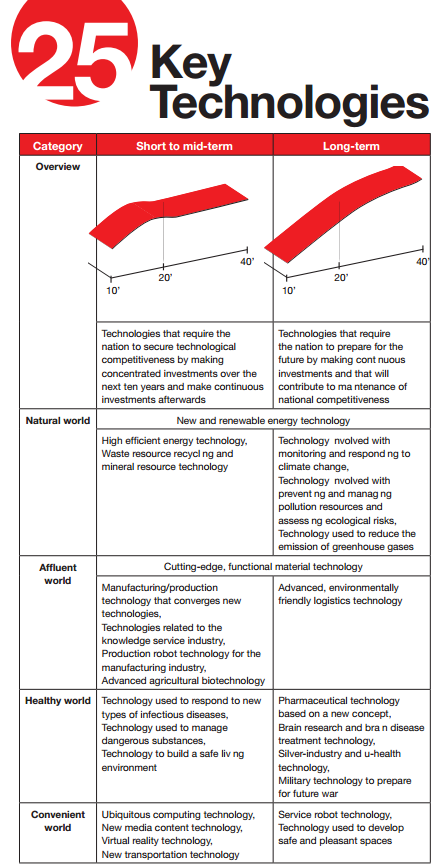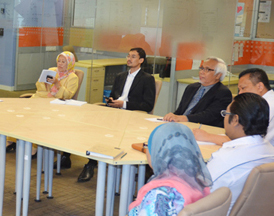by | Yim, Hyun Ph.D., Managing Director, Technology Foresight Center Korea Institute of S&T Evaluation and Planning
The creation and acceptance of new technologies has accelerated in modern times. In future, science and technology will be a key driver of social change. While the convergence of science and technology will speed up the creation of new technologies and industries.
Admittedly, there are significant uncertainties about the future shape of markets, governance and social values. These will impact organizations and influence their capacity to meet their objectives.
In order to prepare for these rapid changes and uncertainties, we should actively respond to future society by establishing a national science and technology vision that incorporates changes in the global environment and the unique conditions of Korea. It has been also more than ten years since the 1st Korean S&T vision, ‘Dream, Opportunity and Challenge of S&T Toward the Year 2025 (1999)’ was devised. There is thus a need to formulate a new science and technology vision for the future in Korea. The vision will provide a new guideline for
scientific and technological development in order to actively respond to the sharp changing future society. This is also expected to present citizens with dreams and hope, and scientists and engineers with a future direction and goals for the development of science and technology. This vision has been formulated through the following process.
Firstly, we have analyzed changes in the global environment and unique conditions of Korea to define a direction for changes in the future environment. Five megatrends are presented, which are meaningful for Korea in 2040. The five megatrends are (1) Intensified environmental and resource issues, (2) Globalization and the advancement of the knowledge-based society, (3) Changes in the population structure, (4) Acceleration in the convergence of science and technology, and (5) Emergence of new security issues. In-depth analysis of the relevant issues for each megatrend is conducted to identify a direction of change. Based on these analyses, we derive a vision and goal in the area of science and technology.
Secondly, the future society of 2040, when the vision is achieved, is concretized into four types of worlds such as natural world, affluent world, healthy world, and convenient world. Natural world takes place by developing clean energy and maximizing the reuse of resources. In the affluent world, a new industrial/ economic structure is formed, owing to materials and production methods that are based on a new concept and green revolution. For a healthy world, incurable and terminal diseases can be treated, state-of-the-art medical services can be provided, and there are no concerns related to security or safety in daily life. For convenient world, there is unrestricted information exchange, resulting from the establishment of a ubiquitous ICT environment, and convenience in daily life is substantially improved through robot services.
Finally, future key technologies and policy directions are proposed to achieve the vision and goal, i.e., to create the four types of worlds. In order to identify future key technologies, candidates that had a high possibility of contributing to building the vision were collected from existing science and technology plans. The final list of 25 future key technologies is selected from the candidates through SWOT analysis and expert surveys. The 25 future critical technologies are divided into 2 groups according to the investment strategy. For the short to mid-term investment, we should focus on acquiring technological competitiveness by making concentrated investments over the next ten years and make continuous investments afterwards.
Technologies related to resolving pending issues, such as new types of infectious diseases, parts and materials, and energy-related measures are included in this group. The green technology that requires the country to preoccupy an advantageous position in the world market and new growth engines that can generate added value are also included. For the long-term investment, we should prepare for the future and contribute to the maintenance of national competitiveness by making continuous investments. For this group, technologies that prepare for the aging society and that realize a safe society are included. World-leading advanced technologies, original green technologies, and new growth engines whose markets have not been fully formed but have great future growth potentials are also added.

Five policy directions represent the general directions for S&T policy that the government should continually focus on to lead the future. The first policy direction is to expand creative and leading R&D. A support for challenging and adventurous research as well as multidisciplinary research should be strengthened to identify new growth engines.
The government should make concentrated investments in basic research that has a high risk of failure in the market, encourage expansion of private sector investments, and establish an environment for the startup of innovative venture companies thatdevelop new technologies. The second one is to cultivate science and technology experts and strengthen the knowledge system. The education and research system should be reformed so that researchers’ creativity and autonomy is respected. The government should also put more emphasis on soft power such as standards and knowledge capital. The third one is to advance S&T innovation system through international cooperation. Open innovation through strategic international cooperation in science and technology should be promoted in order to overcome the issue of limited resources in Korea and to strengthen global science and technology competencies. The government should facilitate strategic joint research with advanced countries and strengthen reciprocal support with developing nations. The fourth one is to move forward with green growth-based technology innovation.
Green technology innovation capabilities should be facilitated for the virtuous cycle of economic development and environmental preservation. The government has to strengthen the system for encouraging private sector investments in the development of green technologies and products. The last one is to strengthen the roles of science and technology in contributing to citizens and society. The roles of science and technology should be facilitated in resolving social issues. The government should increase roles of government R&D in contributing to the improvement of the quality of life, including citizens’ health, safety, and environment. The government also has to enhance the social responsibilities of science and technology and disseminate the culture of science and technology.
Once the vision is realized in 2040, Korea will be one of the world’s top five nations in science and technology that performs as a global leader. Korea is also expected to be a society that raises the value of life and that makes the dreams come true through the development of science and technology. The Korean government is currently working to spread dreams and hope among citizens by presenting a developed image of Korea of 2040 that will be realized through science and technology.










